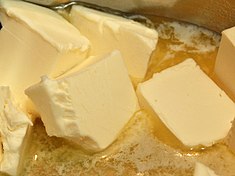Butter

Melted and solid butter
| |
| Nutritional value per 1 US Tbsp (14.2g) | |
|---|---|
| Energy | 101.8 kcal (426 kJ) |
0.01 g
| |
| Sugars | 0.01 g |
11.52 g
| |
| Saturated | 7.294 g |
| Trans | 0.465 g |
| Monounsaturated | 2.985 g |
| Polyunsaturated | 0.432 g |
0.12 g
| |
| Vitamins | Quantity %DV† |
| Vitamin A equiv. |
12%
97.1 μg |
| Vitamin A | 355 IU |
| Vitamin B12 |
1%
0.024 μg |
| Vitamin E |
2%
0.33 mg |
| Vitamin K |
1%
0.99 μg |
| Other constituents | Quantity |
| Cholesterol | 30.5 mg |
| |
| †Percentages are roughly approximated using US recommendations for adults. Source: USDA Nutrient Database | |
Most frequently made from cow's milk, butter can also be manufactured from the milk of other mammals, including sheep, goats, buffalo, and yaks. Salt (such as dairy salt), flavorings (such as garlic) and preservatives are sometimes added to butter. Rendering butter, removing the water and milk solids, produces clarified butter or ghee, which is almost entirely butterfat.
Butter is a water-in-oil emulsion resulting from an inversion of the cream, where the milk proteins are the emulsifiers. Butter remains a firm solid when refrigerated, but softens to a spreadable consistency at room temperature, and melts to a thin liquid consistency at 32 to 35 °C (90 to 95 °F). The density of butter is 911 grams per Litre (0.950 lb per US pint).[1] It generally has a pale yellow color, but varies from deep yellow to nearly white. Its natural, unmodified color is dependent on the source animal's feed and genetics, but the commercial manufacturing process commonly manipulates the color with food colorings like annatto[2] or carotene
source : https://en.wikipedia.org/wiki/Butter
Tidak ada komentar:
Posting Komentar